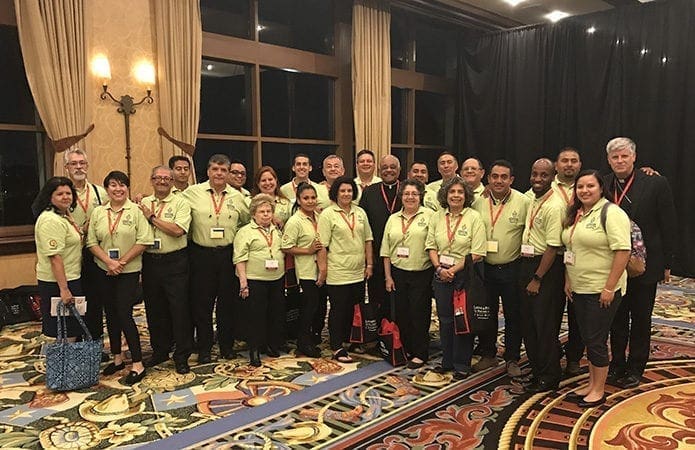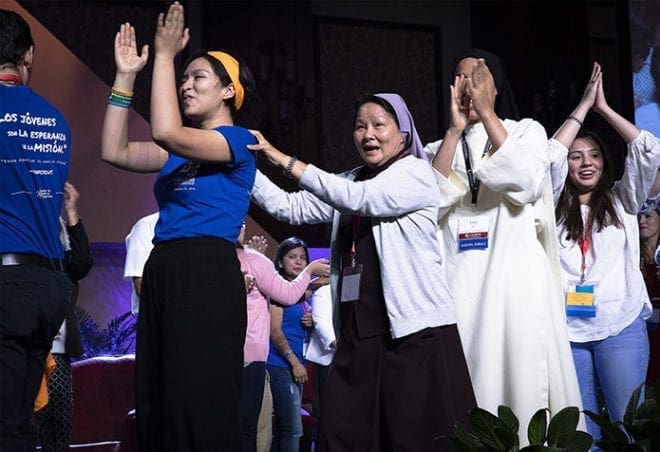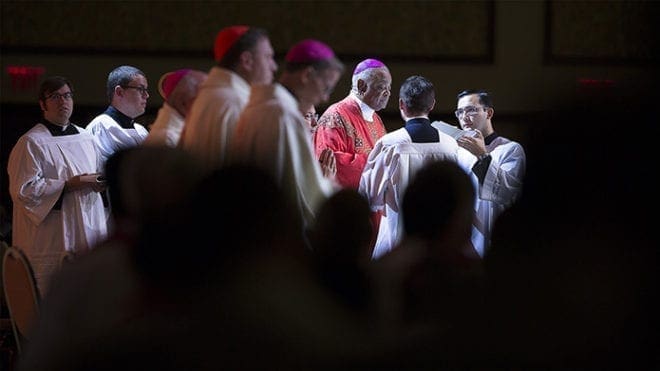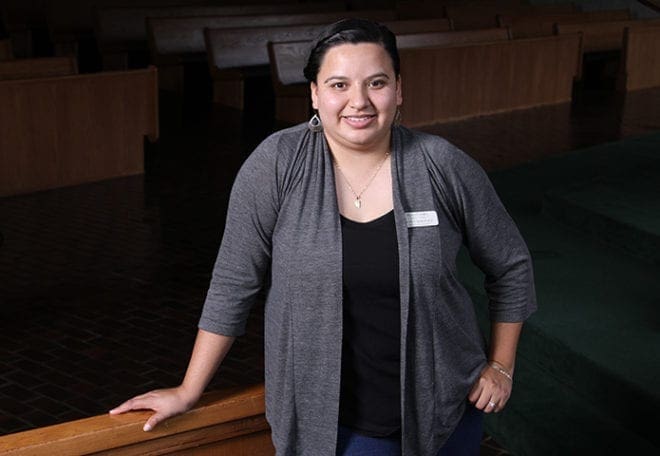
Washington DC
Next Encuentro phase is action by parishes, dioceses on ideas, priorities
By NORMA MONTENEGRO FLYNN, Catholic News Service | Published October 4, 2018 | En Español
WASHINGTON (CNS)— Fifth National Encuentro participants returned to their dioceses and parishes with many challenges and hopes.
Among them, they were called to share their gifts and reach out across race and language barriers in their own parish and diocesan communities; at the same time, they also urged the rest of non-Hispanic Catholics to recognize their presence and open doors to their gifts and contributions.
The Fifth National Encuentro, also called V Encuentro, is a process of missionary work, consultation, leadership development and community building that seeks to develop better ways in which the Catholic Church in the United States can respond to Hispanic Catholics. Over 3,000 Hispanic ministry leaders participated in the Sept. 20-23 event in Grapevine, Texas, representing their parishes and 159 dioceses and other national Catholic organizations and groups.
Hispanics represent about 40 percent of U.S. Catholics and nearly 60 percent of millennial Catholics, according to research from the Center for Applied Research in the Apostolate.

Delegates celebrate the Sept. 23 closing session of the Fifth National Encuentro, or V Encuentro, in Grapevine, Texas. CNS photo/Tyler Orsburn
During the afternoon sessions, representatives for each of the 14 episcopal regions—in which the dioceses of the United States are geographically divided—reported the results of the small group consultations they held throughout the day.
The task at hand was to highlight the areas that need accompaniment the most, and obstacles for Hispanic Catholics in 28 ministerial areas such as vocations, evangelization, Catholic education, family life, immigration and care for immigrants, among others.
And as that phase of the multiyear process reached completion, the next phase is aimed at putting into practice the lessons learned and bear fruits.
“This has been like a retreat, the message that we were given at the end is like you have the Holy Spirit, you have to take it with you and you have to be saints, produce fruits of love,” said Sister Judith Maldonado, a member of the Dominican Sisters of the Lady of the Rosary of Fatima. Her order is involved with family ministry serving parishes in Maryland and Texas.
Recommendations are the next order of business
The V Encuentro attendees included two dozen women and men from Atlanta parishes, as part of a years-long process of evangelization.
“It was a mountaintop experience,” said attendee Ashley Morris, associate director of the Office of Intercultural and Ethnic Diversity of the archdiocese. Morris, who is African-American, said he was treated like family by the Hispanic community with “a feeling of being welcomed.”
Hispanic Catholics soon will represent the majority of Mass-attending Catholics in the United States, and are said to make up about half of the million strong Catholic community in the Archdiocese of Atlanta.
In the next few months, the leadership team of the National Encuentro will distribute a concluding document listing the main priorities and problems identified across the 28 ministry areas; the document will assist dioceses, parishes and national structures in drafting their own pastoral plans according to their own realities and priorities.
The Encuentro’s team of accompaniment, or ENAVE, plans to continue providing support and tracking progress.
“We have achieved things that in some ways we never would have imagined would be possible,” Ken Johnson-Mondragon, V Encuentro’s director of research, told Catholic News Service. “Walls have come down, people have experienced really the joy that Pope Francis talks about.”
A multi-year endeavor
The V Encuentro process that began about four years ago has helped thousands of Hispanic ministry leaders engage in faith-filled dialogues among themselves and reach out to those on peripheries. Encuentro has also promoted collaborations within and across dioceses, which is known as ‘pastoral en conjunto,’ and has helped remove the “fear to speak up,” bringing the participants closer to their pastors and bishops, added Johnson-Mondragon.
The V Encuentro also identified and prepared at least 25,000 new Hispanic ministry leaders across the country, and about a third of the leaders engaged were youth and young adults. An estimated 100,000 individuals participated in the process and about 150,000 others were reached on the peripheries.

Archbishop Wilton D. Gregory of Atlanta concelebrates Mass Sept. 21 on the feast of St. Matthew during the Fifth National Encuentro, or V Encuentro, in Grapevine, Texas. The Sept. 20-23 event included more than 3,200 Hispanic Catholic leaders and about 125 bishops from across the country. CNS photo/Tyler Orsburn
Another important gain is that the V Encuentro has captured the attention and support of the bishops nationwide. At the gathering, about 125 bishops—Hispanic and non-Hispanic—walked side by side with their diocesan delegations, and about 160 out of 178 Roman Catholic dioceses and archdioceses in the country were represented. Bishop Bernard E. Shlesinger III, of Atlanta, was among the group of bishops in attendances, as well as Archbishop Wilton D. Gregory.
Engaging with young Hispanic Catholics is key for church leaders. Among younger Catholics, Latinos make up most of the people in the pews. According to the Encuentro program, 40 percent of all Catholics in the U.S. today are Hispanic; 50 percent of Catholics ages 14 to 29 are Hispanic; and 55 percent of Catholics younger than 14 are Hispanic.
During the conference, one evening was reserved for dinner shared by bishops and hundreds of young adults.
“The Hispanic church is asking for formation, they’re asking for support, they’re asking for direction, so it will be on the part of the bishops and pastors to provide that,” Bishop Oscar Cantu told CNS. Formerly head of the Diocese of Las Cruces, New Mexico, he is now coadjutor bishop of San Jose, California.
What mostly surprised and pleased Bishop Cantu was the size of the gathering—with over 3,000 participants—and like many others, he was energized by the optimism and drive of the attendees.
As a priest ministering in North Carolina, Bishop Shlesinger was pastor of a community with a large number of Hispanic Catholics, Our Lady of Guadalupe Church in Newton Grove. During his nine years as its leader, he said he must have baptized 1,000 children. The faith and liveliness of the Hispanic faith and the culture is a “gift” for the church to embrace, he said.
Bishop Shlesinger attended a workshop on immigration where speakers talked about the plight of young adults brought to the United States as children, among other issues. The current situation forces people to live in a “state of ambiguity” with an unknown future, the bishop said. More than ever, the church needs to accompany the Hispanic community, he said, as called by Pope Francis.
Top areas identified, discussed
The top three recommendations that rose up in the Encuentro process are: the need to develop pastoral plans for Hispanic ministry tailored according to the needs of each parish and diocese; the need of the parish community to help strengthen families; and to hire more Hispanic young adults in paid positions of leadership.
The 28 ministry areas addressed by the V Encuentro include those that reach out to youth, young adult, college campuses, immigrants, families, people with disabilities, and the incarcerated, as well as ministries in vocations, pro-life, faith formation and catechesis, justice and peace, and even care for the environment among others.

Estela Martinez, a parishioner at St. Thomas the Apostle Church, Smyrna, was 8 years old when Encuentro 2000 (IV Encuentro) took place. Martinez, 26, was one of two young adults to join a delegation of some 20 people from the Archdiocese of Atlanta at the Sept. 20-23 National Fifth Encuentro in Grapevine, Texas. Photo By Michael Alexander
As a word of advice from Mercy Sister Ana Maria Pineda, who has witnessed all the Encuentros, it is important to connect the previous Encuentros to the current one, while staying focused on the work at hand amid the challenges it might present.
“We’re being called to a very special moment in time and we need to step up to the plate to make sure that we are on the side of the poor, on the side of those who can’t protect themselves.” Sister Pineda said.
Continued conversations the key
For 26-year-old Estela Martinez, the conversations are key between young people and bishops.
“It’s very important to have that one on one. They were willing to listen. That begins the conversation. He took us seriously,” she said about Bishop Jaime Soto of Sacramento, California.
Panelists during the conference showcased the diversity of the Hispanic community, with women being represented as well as men, and speakers spanning the ages, she said. Martinez, who attends St. Thomas the Apostle Church, Smyrna, said she realized in talking with others how fortunate the Archdiocese of Atlanta is to have parishes commit dollars and resources to youth programs.
For Augusto Michael Trujillo, the conference is a family tradition. In 1985, his father attended for the Archdiocese of Atlanta for the III National Encuentro, and in 2000, his mother did the same for IV Encuentro.
Trujillo, relationship manager for Catholic Relief Services, said, “It was an emotional gathering for me as I felt as if the torch my parents passed on to me was now being passed on to younger leaders in our church.”
He said towards the end of the conference in Texas one of the presenters asked all the bishops in attendance to stand. The community affirmed their support of the bishops with the chant, “We love you.”
Where to go from here?
Bishop Shlesinger said the conference reinforced for him the need to facilitate and foster leaders in the Hispanic community and ensure the community is integrated into church life, not just an afterthought. It is time to “unleash their potential,” he said.
Morris said he is encouraged to work to build bridges between the Hispanic and the black Catholic community “to share with the joy of what it means to be a follower of Christ.”
Of the seven predominantly black Catholic churches in the archdiocese, three of the churches now have sizable Hispanic memberships, he said. There is more in common that what separates us, emphasized Morris.
“At the end of the day, Christ is what brings us together,” he said.
Staff Writer Andrew Nelson contributed to this story.